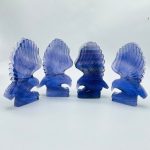Introduction

The serpentine gemstone, with its captivating verdant hues and enigmatic energy, has long been revered for its healing powers and spiritual significance. From ancient civilizations to modern-day healers, this remarkable stone has played an integral role in spiritual practices, folklore, and holistic healing traditions. This comprehensive guide delves into the multifaceted meaning of serpentine, exploring its historical significance, geological properties, metaphysical beliefs, and practical applications.
Geological Formation and Composition
Serpentine is a metamorphic rock primarily composed of serpentine minerals, which are hydrated magnesium silicate minerals. It is formed when igneous rocks, such as peridotite, undergo hydrothermal alteration, a process involving the interaction of hot water with the rock’s minerals. This alteration leads to the development of a distinctive fibrous texture and a characteristic greenish color that can vary from olive to dark green.
Historical Significance
Serpentine has a rich and varied history, dating back to ancient times. In ancient Egypt, it was believed to represent the goddess Isis, who symbolized fertility, motherhood, and healing. The Greeks associated serpentine with Asclepius, the god of medicine, and often used it in the form of bracelets to promote healing. Throughout history, serpentine has been used as a protective amulet, as it was believed to ward off negative energies and bring prosperity.
Metaphysical Beliefs
Serpentine is closely associated with the element of earth and the root chakra, the energy center located at the base of the spine. It is believed to possess grounding and stabilizing properties, helping individuals connect to the Earth’s energy and feel a sense of security and stability. Additionally, serpentine is said to promote spiritual growth, emotional healing, and inner peace.
Healing Properties
Traditional healers and crystal enthusiasts believe that serpentine possesses numerous therapeutic properties. It is often used to address physical ailments such as:
- Digestive issues
- Skin conditions
- Muscle spasms
- Infections
Furthermore, serpentine is said to have emotional and mental benefits, such as:
- Calming anxiety and stress
- Promoting emotional healing
- Enhancing mental clarity and focus
Practical Applications
Beyond its metaphysical and healing properties, serpentine also has practical applications in various fields:
- Jewelry: Serpentine’s unique coloration and texture make it a popular choice for jewelry, including necklaces, bracelets, and earrings.
- Carvings: Serpentine has been used for centuries to create intricate carvings, sculptures, and figurines.
- Construction: Due to its durability and fire resistance, serpentine is sometimes used as a decorative building material, particularly for flooring and countertops.
Tips and Tricks for Using Serpentine
- Wear serpentine jewelry: Close proximity to the body allows the gemstone’s healing energies to be fully absorbed.
- Meditate with serpentine: Hold a piece of serpentine in your hand or place it on your root chakra during meditation to promote grounding and emotional healing.
- Carry serpentine in your pocket or bag: This allows you to carry its protective and calming properties wherever you go.
- Use serpentine in water: Add serpentine stones to a water bottle or bathwater to infuse the liquid with its healing energies.
Pros and Cons of Serpentine
Pros:
- Grounding and stabilizing energy
- Promotes emotional healing and inner peace
- Believed to alleviate physical ailments
- Versatile for jewelry, carvings, and construction
Cons:
- Can be difficult to find in large sizes
- May be prone to scratching or breaking
- Some varieties of serpentine can contain asbestos, making them potentially harmful if inhaled
Table 1: Physical Properties of Serpentine
| Property | Value |
|---|---|
| Chemical composition | Hydrated magnesium silicate minerals |
| Color | Green (ranging from olive to dark green) |
| Hardness | 4-5 on the Mohs scale |
| Cleavage | None |
| Crystal system | Monoclinic |
Table 2: Metaphysical Properties of Serpentine
| Property | Attributes |
|---|---|
| Element | Earth |
| Chakra | Root chakra (located at the base of the spine) |
| Healing properties | Grounding, emotional healing, inner peace |
| Protective properties | Wards off negative energies |
Table 3: Practical Applications of Serpentine
| Application | Use |
|---|---|
| Jewelry | Necklaces, bracelets, earrings |
| Carvings | Sculptures, figurines |
| Construction | Flooring, countertops |
Table 4: Tips and Tricks for Using Serpentine
| Tip | Benefit |
|---|---|
| Wear serpentine jewelry | Allows healing energies to be fully absorbed |
| Meditate with serpentine | Promotes grounding and emotional healing |
| Carry serpentine in your pocket or bag | Provides protection and calming properties on the go |
| Use serpentine in water | Infuses water with healing energies |
Conclusion
The serpentine gemstone is a multifaceted stone with a rich history, geological significance, and spiritual appeal. Its grounding and emotionally healing properties have made it a popular choice for alternative healing practices, while its unique coloration and texture have led to its use in jewelry, carvings, and decorative building materials. By understanding the meaning and properties of serpentine, individuals can harness its energy for personal growth, healing, and practical applications.




























